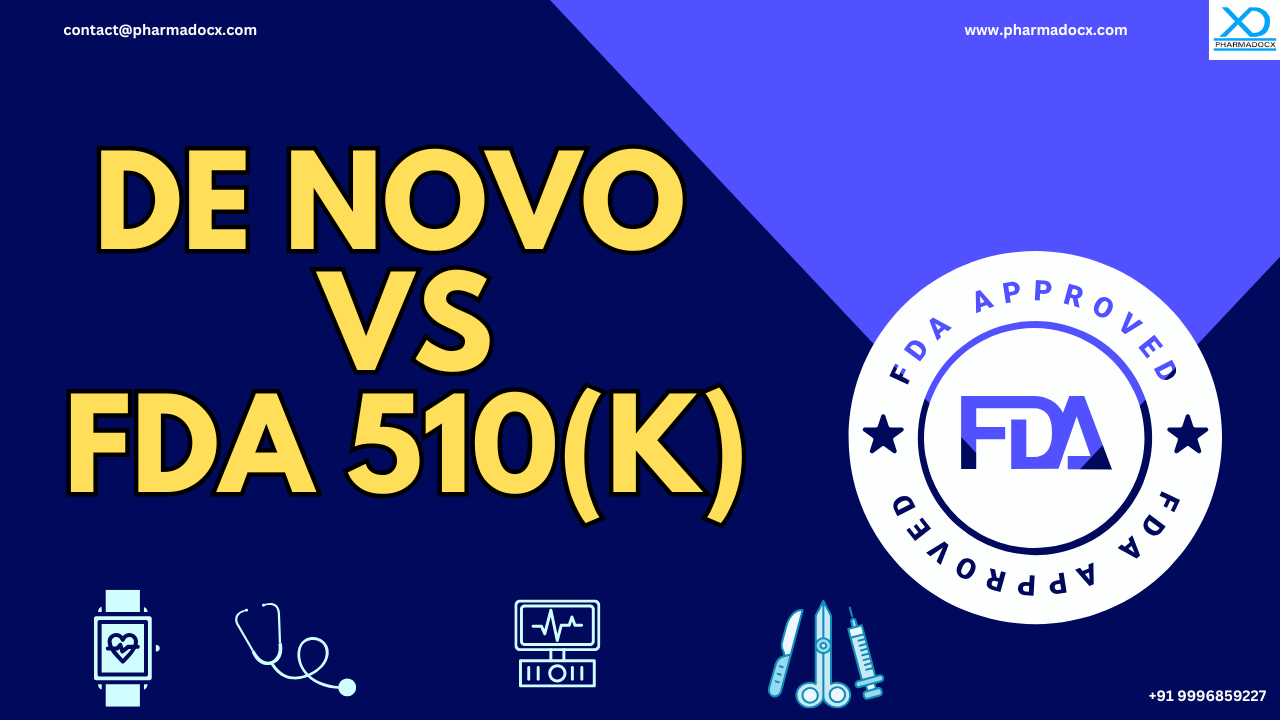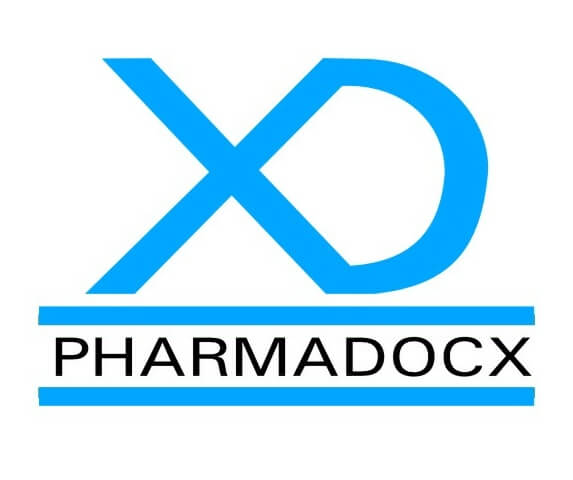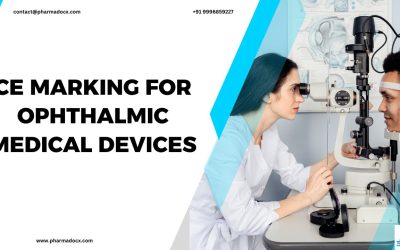The US FDA offers multiple regulatory pathways for medical devices entering its market. In this blog, we have highlighted the differences between US FDA De Novo and FDA 510(k) pathways.
FDA De Novo and FDA 510(k)
To understand the differences between FDA De Novo and FDA 510(k) pathways, we need to understand the two pathways first. Hence, we have provided a brief introduction to FDA De Novo and FDA 510(k) pathways. This will help you choose the correct regulatory pathway for your medical device.
What is FDA De Novo pathway?
FDA De Novo application is required when no viable predicate device is available for the new medical device. The De Novo pathway is the viable regulatory route for innovative devices posing minimal risk to patients. Moreover, the device should not fall in any existing classification regulation. The medical device manufacturer will have to file a De Novo application. Additionally, the probable risks and benefits of the device as well as how to mitigate the risks using general and special controls have to be mentioned. Furthermore, general and special controls should be able to assure safety and effectiveness of the new medical device. Key requirements for FDA De Novo application:
- No valid predicate device should exist for proving substantial equivalence.
- General controls (or general and special controls) must provide a reasonable guarantee of safety and effectiveness of the medical device.
Key points to remember for FDA De Novo application:
- Benefit-risk analysis: De Novo submissions require detailed benefit-risk analysis.
- Justification for classification: Extensive justification is required for the proposed FDA medical device classification (Class I or II).
- Additional requirements: Additional testing requirements are needed for FDA De Novo application as opposed to US FDA 510(k) clearance process.
FDA authorities will review the safety and effectiveness of the medical device based on clinical data and performance testing. Once satisfied, the FDA assigns the device a classification. Thus, the De Novo pathway can be used to establish a new regulatory classification (Class I or II) for future similar devices.
When should you opt for the De Novo pathway?
You should opt for the FDA De Novo pathway under the following conditions:
- When there is no existing device that can serve as a predicate device for your new device
- The device does not qualify for US FDA premarket approval (PMA), which is primarily intended for Class III or high-risk devices.
- You need to establish a new regulatory medical device classification for similar future devices.
- General and special controls are sufficient for ensuring safety and effectiveness of the medical device.
Once the De Novo is granted, the medical device can be immediately marketed in the US. The classification will be published in the Federal Register. Additionally, the controls necessary to provide reasonable assurance of safety and effectiveness of the medical device will be mentioned. Furthermore, once the De Novo is granted, the device will be permitted to serve as a predicate for future 510(k) applications. If the De Novo pathway application is rejected, the device cannot be marketed without further efforts by the applicant and acceptance by the FDA.
What is US FDA 510(k) clearance process?
FDA 510(k) clearance process is a less rigorous process used for approval of medium-risk medical devices, such as Class I and II devices. This process is used only for medical devices having a predicate device. This premarket notification process is used to demonstrate the device in question is as safe and effective as the “substantially equivalent” device being sold legally in the US. This process involves evaluating and comparing the device with the “substantially equivalent” device. This similar product or “substantially equivalent” device is known as the predicate device.
Devices covered under US FDA 510(k): US FDA 510(k) covers mostly low-risk Class I and II medical devices. These devices are required to mandatorily have a substantially equivalent predicate device. Furthermore, if a significant change is introduced to a legally marketed device, a US FDA 510(k) premarket notification will be required. A modification that could substantially affect the device’s safety, effectiveness, or intended use will be considered a “significant change”. Moreover, domestic medical device and IVD manufacturers who are trying to introduce new devices to the US market will have to secure the FDA 510(k) clearance. Additionally, re-labellers or re-packers who make device labelling changes will also require this clearance.
Requirements for 510(k) clearance
The following basic information will be required for securing 510(k) clearance:
- The device’s name
- The device classification
- Location where the device will be launched in the market
- Actions taken to abide by performance standards
- A comparison with other similar devices
- Clinical trial data, if applicable
- Potential ideas for labels and advertisements that will properly demonstrate the device’s use
- A financial certification
US FDA 510(k) clearance process
US FDA 510(k) is a premarket notification having a specific format. The process is less rigorous and tedious. The applicant is required to demonstrate the new device is substantially equivalent to a legally marketed predicate device. Additionally, the applicant is required to provide performance data proving equivalency.
The applicant is required to demonstrate the following:
- The new device is as safe and effective as the predicate device.
- The new device has the same intended use as the predicate.
- The new device has similar technological characteristics as that of the predicate device. However, if different, it should not raise new safety concerns.
The US FDA 510(k) submission must be sent to the appropriate FDA centre. The regulatory officials will validate the comparison providing evidence for substantial equivalence claims. Until the applicant has received a response from the FDA confirming their device’s clearance, they are not permitted to market their device. Only after the US FDA accepts the application proving substantial equivalence, the device is considered clear for market launch in the US.
What are the major differences between US FDA De Novo and FDA 510(k) pathways?
We have highlighted the major differences between US FDA De Novo and FDA 510(k) pathways.
1. Predicate device requirement: 510(k) requires a predicate device to demonstrate substantial equivalence. On the other hand, De Novo pathway does not require a predicate device.
2. Innovation level: 510(k) is suitable for improvement innovations or modifications of existing medical devices. De Novo is mostly designed for first-of-a-kind devices that are not high-risk but lack predicate.
3. Regulatory burden: 510(k) has less complex documentation and mainly focuses on equivalence. However, De Novo pathway requires extensive data, including benefit-risk analysis and justification for classification.
4. Review Process: 510(k) is faster and more streamlined. In this process, FDA assesses equivalence. On the other hand, De Novo is more rigorous. In this process, FDA evaluates safety and effectiveness of the medical device.
6 Key differences between US FDA De Novo and FDA 510(k) pathways
| Feature | US FDA 510(k) | De Novo |
|---|---|---|
| Purpose | For devices substantially equivalent to a legally marketed predicate device | For low to moderate risk novel devices with no predicate |
| Predicate requirement | Yes | No |
| US FDA User Fees | ~$21,870 | ~$145,800 |
| Time to market | ~90 days | ~150 days |
| Documentation | Less extensive | Extensive with requirement for benefit-risk analysis |
| Market Access | Faster | Longer with new classification establishment |
When to choose De Novo and when to choose 510(k)?
- You have a similar device in the market: 510(k) pathway
- Your device is novel with no predicate: De Novo pathway
Choosing the right US FDA regulatory pathway for your medical device may be complicated. You need to understand the differences between US FDA De Novo and FDA 510(k) pathways to identify the correct pathway for your medical device. We at Pharmadocx Consultants will make your US FDA regulatory journey easy. Simply email at [email protected] or call/Whatsapp on 9996859227. Our team will help you identify the right regulatory pathway for your medical device, prepare the application, prepare the necessary documents, and help you easily secure the approval.





